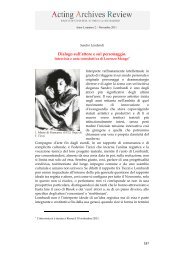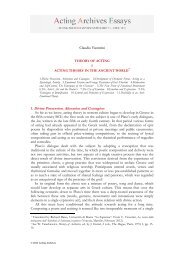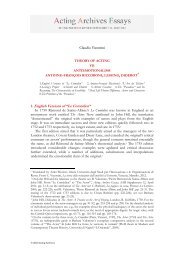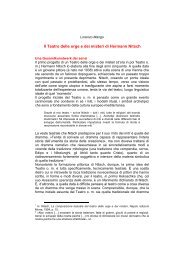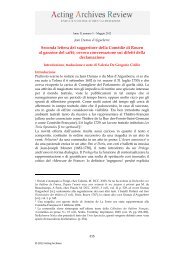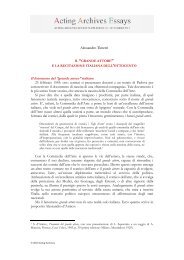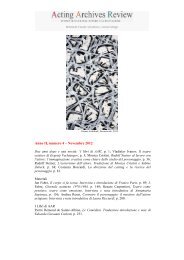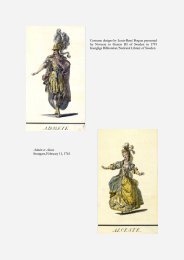Maria Ines Aliverti_The Miniatures of Jean Louis ... - Acting Archives
Maria Ines Aliverti_The Miniatures of Jean Louis ... - Acting Archives
Maria Ines Aliverti_The Miniatures of Jean Louis ... - Acting Archives
You also want an ePaper? Increase the reach of your titles
YUMPU automatically turns print PDFs into web optimized ePapers that Google loves.
AAR <strong>Acting</strong> <strong>Archives</strong> Essays Supplement 10 – April 2011<br />
connoisseur. It is worth considering that at the end <strong>of</strong> January 1770 the Comédiens<br />
Français left their old and glorious theatre, located in rue des Fossés-Saint-Germain<br />
and inaugurated in 1689, for a new temporary settlement in the Salle des Machines at<br />
the Tuileries Palace, then accessible from rue Saint-Honoré, as the rue de Rivoli did<br />
not exist at the time. Shall we suppose that a collective author (the Comédiens) is<br />
concealed behind this undeclared authorship? In this case Les Métamorphoses may have<br />
been intended as a memorial book <strong>of</strong> the troupe at a turning point in their collective<br />
identity. <strong>The</strong> title, by the way, points to a transforming process that involved both<br />
the two institutional societies <strong>of</strong> actors: the Comédiens Français and the Comédiens<br />
Italiens, the latter having merged in 1762 with Favart’s troupe <strong>of</strong> the Opéra<br />
Comique.<br />
Immediately afterwards, during Faesch’s visit, the first English edition <strong>of</strong> Les<br />
Métamorphoses was published in London: <strong>The</strong> Metamorphoses <strong>of</strong> Melpomene and Thalia,<br />
London [c.1770], together with the first edition <strong>of</strong> Dramatic Characters, with a<br />
dedication from the publisher Robert Sayer 39 to David Garrick, and with a double<br />
title-page, French and English, which stated the date <strong>of</strong> authorization for publication<br />
as 15 January 1770. 40 In this case, too, the vignettes were printed anonymously and<br />
they had been issued separately between October and December 1769. <strong>The</strong><br />
patronage <strong>of</strong> Garrick, implicitly testified by the dedication, was undoubtedly<br />
important to the initiative, which, in the selection <strong>of</strong> the English images, was clearly<br />
linked to the theatrical conversation pieces <strong>of</strong> Wilson and, in particular, <strong>of</strong> Z<strong>of</strong>fany.<br />
Leaving aside for the moment the problems related to the paternity <strong>of</strong> these<br />
vignettes, it will suffice to note the chronology <strong>of</strong> the editions: first edition <strong>of</strong> Les<br />
Métamorphoses in Autumn 1769, Faesch’s departure for England at the end <strong>of</strong> 1769,<br />
perhaps bearing the book to present to Garrick, the plan to print it in England (the<br />
permit was issued in mid-January 1770), perhaps on the spur <strong>of</strong> the moment, perhaps<br />
agreed between Lekain and Garrick, replacing a project <strong>of</strong> 1766-1768 which it had<br />
not been possible to realize. However, the solution adopted – to draw the English<br />
vignettes from the conversation pieces – as well as the fact that the French set seems<br />
to have been re-engraved in London, would seem to suggest that the initiative was<br />
not planned in detail, but adapted very quickly when the opportunity arose. Sayer, the<br />
enterprising publisher and friend <strong>of</strong> Z<strong>of</strong>fany, who took on the expense <strong>of</strong> the<br />
39 Robert Sayer (1725-1794) ran the largest print publishing business in eighteenth-century London<br />
located in Fleet Street (in the years 1770-1773: Robert Sayer at the Golden Buck in Fleet Street; Robert Sayer,<br />
N° 53 Fleet Street; Rob.t Sayer & Co. Fleet Street. London). He published and re-published prints after<br />
major paintings and a multitude <strong>of</strong> lesser plates, copies and piracies. Around 1770 Robert Sayer and<br />
John Smith printer (N° 35 Cheapside) joined to produce theatrical prints. In 1774 Sayer took a former<br />
apprentice, John Bennett, into partnership. General catalogues were issued in 1766 (Robert Sayer’s New<br />
and Enlarged/Catalogue For the Year M.DCC.LXVI.), in 1775 (Sayer and Bennett’s Enlarged Catalogue <strong>of</strong> New<br />
and Valuable Prints, in Sets, or Single, reprinted by <strong>The</strong> Holland Press, London, 1970) and in 1786<br />
(untraced). See Antony Griffiths, ‘A Checklist <strong>of</strong> Catalogues <strong>of</strong> British Print Publishers c.1650-1830’,<br />
Print Quarterly, 1 (1984), 4-22; Christopher Lennox-Boyd, <strong>The</strong>atre in the Age <strong>of</strong> Garrick: English Mezzotints<br />
from the Collection <strong>of</strong> the Honorable Christopher Lennox-Boyd, (exh. cat., London, Courtauld Institute<br />
Galleries, 1994), London, Ch. Lennox-Boyd, 1994, p. xi. An advertisement by Sayer related to ‘<strong>The</strong><br />
Dramatic Characters <strong>of</strong> the English, French, and Italian Stages’ appeared in <strong>The</strong> Morning Chronicle (11<br />
February 1774), see Ch. Lennox-Boyd, <strong>The</strong>atre in the Age <strong>of</strong> Garrick, p. 60 and p. 62 (note 2).<br />
40 This first edition <strong>of</strong> Dramatic Characters with two engraved title pages (one in French and one in<br />
English) and a letter-press table <strong>of</strong> contents, containing a first set <strong>of</strong> 24 plates is rare. More frequently<br />
I found issues <strong>of</strong> the second edition in which the number was increased by 14 new plates, or more.<br />
14



